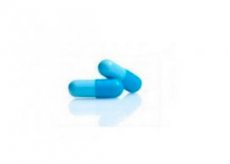Medical expert of the article
New publications
Preparations
Chlormhinalald
Last reviewed: 23.04.2024

All iLive content is medically reviewed or fact checked to ensure as much factual accuracy as possible.
We have strict sourcing guidelines and only link to reputable media sites, academic research institutions and, whenever possible, medically peer reviewed studies. Note that the numbers in parentheses ([1], [2], etc.) are clickable links to these studies.
If you feel that any of our content is inaccurate, out-of-date, or otherwise questionable, please select it and press Ctrl + Enter.

Chlorhinalaldol is an antibacterial agent of artificial origin. Included in the category of quinoline derivatives.
Indications of the chlorchinaldole
It is used to eliminate infections that develop inside the intestine (such as salmonellosis, dysentery, foodborne toxicity, progesteritis, staphylococcus or other enterobacteria caused by intestinal infections, and in addition, dysbacteriosis (a disorder of the intestinal microflora balance)).
In gynecological practice, the medicine is used to eliminate vaginal infections of an infectious and inflammatory nature, provoked by fungi, bacteria or trichomonads.
Release form
The release occurs in tablets with a volume of 0.1 g. In the box - 50 such tablets. It is also produced in tablets with a volume of 0.03 g (children's).
Can also be produced in the form of vaginal suppositories.
Pharmacodynamics
The drug has antiprotozoal antimycotic and antibacterial properties. Oppressing the activity of protozoa. The most effective Chlorhinaldol affects gram-positive (in particular coccal type), and at the same time, individual Gram-negative microorganisms.
Dosing and administration
Use the medication orally after eating. The size of an adult's portion is 0.2 g, taken three times a day. In mild forms of the disease, 0.1 g of drugs are administered, also three times per day. If a person has a severe form of infection (eg, amebic dysentery), a maximum of 1.2 grams of medication per day is allowed.
Serving size for children:
- infants 1-2 years: a single dose of drugs is 0.03 grams, and daily - 0.09-0.12 g;
- children 3-6 years of age: the size of a single dose is 0.03-0.06 g, the total daily - 0.15-0.18 g;
- for the age of 7-10 years: a single dose of 0.06-0.09 g, total daily - 0.24-0.3 g.
The sizes of portions of children are calculated according to the scheme of 10 mg / kg of weight. With mild forms of pathology - up to 5 mg / kg.
For the treatment of amoebiasis (an infection that is provoked by the action of dysenteric amoebae, with inflammation in the area of the large intestine of a chronic nature, ulcers are formed against the background of this lesion), and a lambliasis (an infection that is provoked by lamblia activity) is allowed to be raised, but not more than 15 mg / kg.
The course of therapy usually lasts 3-5 days. The maximum duration of treatment is 1 week.
For the introduction of intravaginal - 1 suppository should be introduced into the vagina, once a day, before bedtime. The duration of such therapy is 1 week.
 [1]
[1]
Use of the chlorchinaldole during pregnancy
Chlorhinaldol is not prescribed for pregnant women.
For the period of therapy, it is also required to refuse breastfeeding.
Contraindications
The main contraindications:
- hypersensitivity to 8-hydroxyquinoline derivatives (such as nitroxoline, quinazole, etc.);
- presence in the anamnesis of allergic symptoms;
- renal or hepatic diseases in severe degree;
- pathologies affecting the optic nerves;
- disorders in the PNS area.
Side effects of the chlorchinaldole
The use of drugs can cause vomiting, increased heart rate, abdominal pain, skin rashes, nausea and headaches. If such symptoms appear, you need to reduce the dosage of the drug or completely cancel its administration.
However, the use of the drug (as well as other derivatives of 8-hydroxyquinoline) can lead to the appearance of such side effects : myelopathy, peripheral neuropathy, as well as damage affecting the optic nerve.
To prevent such complications, it is necessary to follow the drug regimen carefully, not exceeding the prescribed dosages and the prescribed duration of the course.

Storage conditions
Chlorhinaldol is stored in standard conditions for medicines, in a dark place, closed from children.
 [4]
[4]
Shelf life
Chlorhinaldol is allowed to be used for 2 years after the release of the drug.

Attention!
To simplify the perception of information, this instruction for use of the drug "Chlormhinalald" translated and presented in a special form on the basis of the official instructions for medical use of the drug. Before use read the annotation that came directly to medicines.
Description provided for informational purposes and is not a guide to self-healing. The need for this drug, the purpose of the treatment regimen, methods and dose of the drug is determined solely by the attending physician. Self-medication is dangerous for your health.

